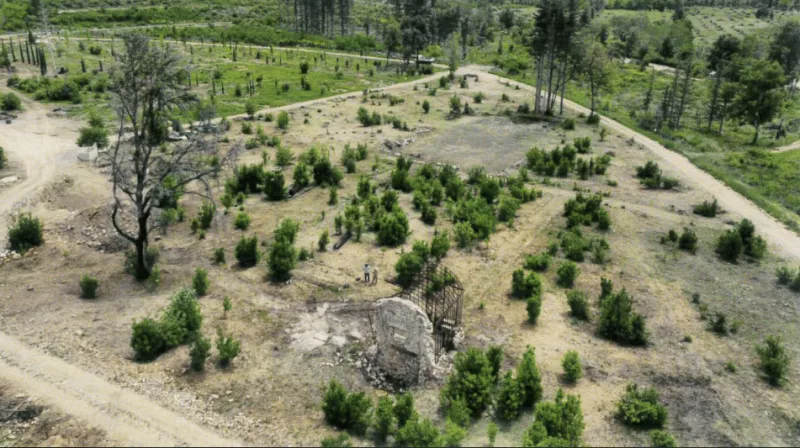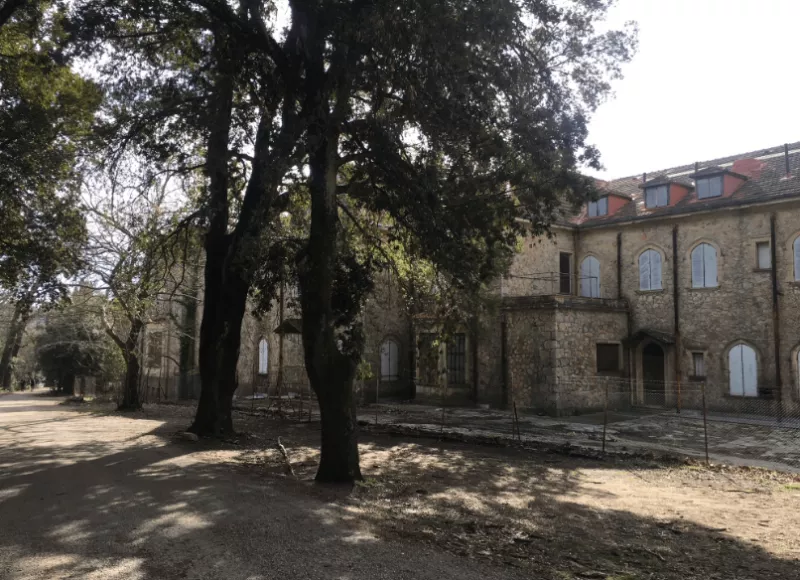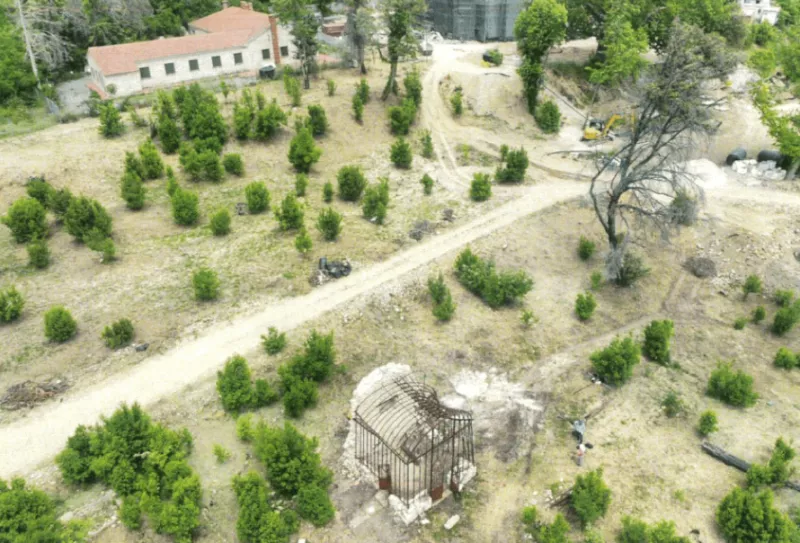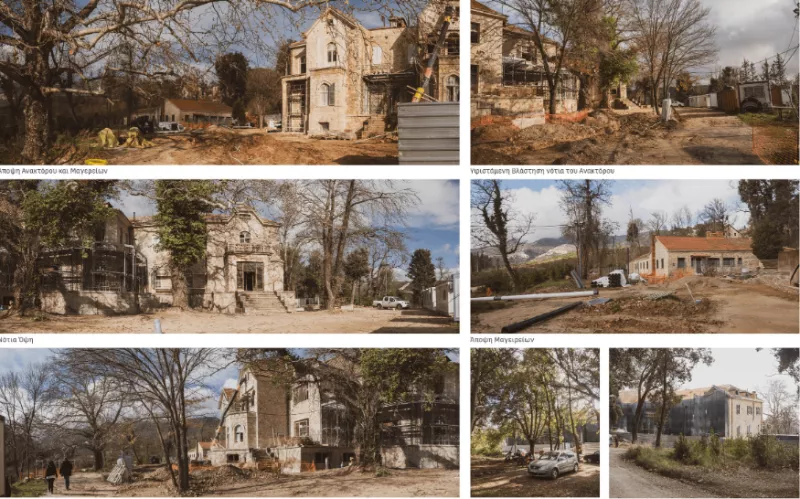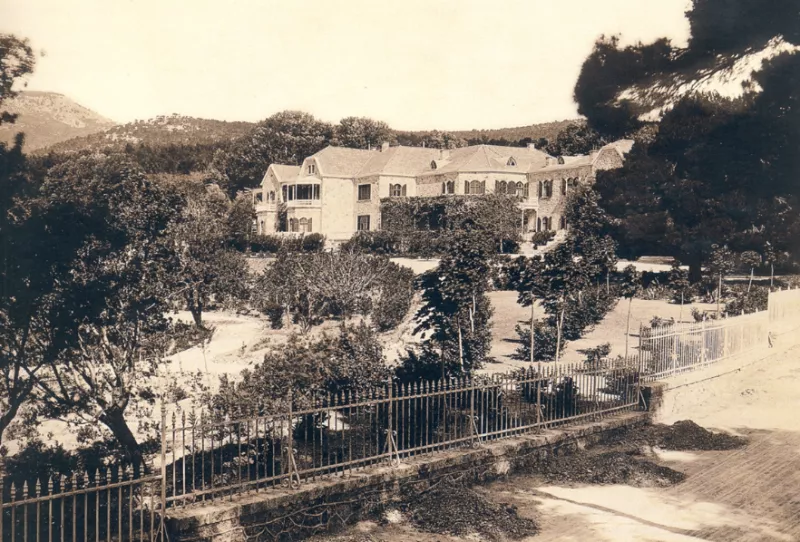The work of the overall reconstitution of the surrounding area and the trail network, around the palace, which harmoniously connecting the monumental buildings to the natural landscape, is in full swing. Royal Estate Tattooallowing visitors to experience the unique identity of the estate as a single experience of history and nature. The project concerns the restoration of the landscape, the palace and agricultural unit of the estate, including the greenhouse and tennis court, which are restored and reused.
The Minister of Culture, Lina MendoniHe stated: “The restoration of the environment of the palace and other monuments in the royal estate is an integrated intervention as important as the restoration and promotion of the monumental building stock. Our goal is to restore and reconstitute outdoor space, with an emphasis on aesthetic and functional browsing quality, to create a single and seamless experience for the visitor. The design is based on the perception of space as a single set that links the interior and exterior of the buildings, forming successive images of the discovery of the landscape and its historical references. The organization of movements, the selection of appropriate materials and plantings, as well as the highlight of the individual sections of the site, serve the goal of creating a visiting and sustainable historical and cultural landscape. The project, along with the restoration of the ongoing palace gardens, covers a total area of 34 acres. The greenhouse and tennis court, integral elements of the historic garden, are completely restored, enhancing the consistency of the procedure. Thus, a single, visited and organized space of high historical, architectural and natural value is shaped, highlighting the unique character of the Tatoi Historical Place. “
Restoration of landscape in palace and agricultural unity
The project focuses on the immediate surroundings of the palace unit, with an area of 5,127 sq.m. as well as part of the productive module of 19,764 sq.m. The basic parameters and principles of the study, included, include:
a) Utilizing documentation (photos, topographic),
b) respect for the environment and historical continuity of space,
(c) Analysis of soil and existing vegetation morphology,
(d) Use of herbal material to highlight landscape and collective memory;
(e) Highlighting panoramic and limited views,
f) Keeping the new Fire Protection Regulation (2023) with distinction in three planting zones around the buildings.
Palace section
In the palace unit, the project concerns the restoration of the surrounding area, the level of the palace and the kitchens, which constitutes the introductory unity in visitors’ tour, in the historical set. North of the palace unity, the outdoor space is defined by Alea with the Aries. The alley is reinforced with new aries and maintains the natural relief. West, a cluster of trees, according to archival sources, is reconstituted, and the path to the cookery with new plane trees and shrubs is enhanced. To the south, historical flower beds of geometric layout, with rhodony and historical varieties, are restored, and the marble sedentary bench is also restored. To the east of the palace is a path, the course of which connects the southern courtyard of the palace with the historical trail crossing the grove in the northern part, in an attempt to connect the outdoor areas around the palace.
Productive unity
The design in the productive unity aims to maintain landscape physiognomy, maintain and enhance existing vegetation. The central element of the design is the creation of Alea with plane trees along the north-south axis to the cemeteries, accompanied by wild sowing and placement of natural living rooms. The presence of trees on either side of the movement axis is identified by photographic archive material. North of the old Voustasi, the square with the oaks is formed. The existing shrubs are maintained on the perimeter of the site by enhancing the character of introversion. In the next outdoor spatial unit, south of the old Voustasi and Hippostasios and north of the New Voustasi, an outdoor space is formed. Planting enhances functionality and aesthetics and is based on the microclimate and in harmony with the natural palette of the area. In total, 95 new trees of various kinds are planted, respecting the natural and cultural identity of the landscape.
Pathway
The trails in the immediate surroundings of the palace and the kitchens are formed in relation to the marches connecting the two buildings. The trails are manufactured with water -permeable materials (crushed stone, sand, soil) and placed on three -dimensional agents for high durability and stability. This solution improves microclimate conditions, enhances biodiversity, reduces floods and enriches the aquifer.
Grove and spatial section around palace
North and in immediate proximity to the palace unity and Alea with Aries, there is a grove of broad -leaved trees, which is part of the European Press Bosco that often responds around the palaces of the same period. The grove north of the palace is spatulating the building with its presence actively involved in the spatial perception of the buildings, while also an extension of the immediate surroundings. For this spatial unit of total area of approximately 6,500 sq.m. It is foreseen to create informal routes, with the aim of linking the grove to the palace surrounding area and the network of historical trails. At the northwestern end of the grove there is a sloping sloping plateau, documented by archival material and topographic drawing of 1897. The plateau included flower beds in a semicircular arrangement around a circular planting area, in the center of which was located. This configuration is restored as an element of the palace’s surroundings, by planting tall shrubs on the perimeter.
The Tatoi estate was acquired by George I in 1872 and in the following years it was developed by the construction of the palace (1886) and the gardens (1890). The great fire of 1916 destroyed part of the estate, but the new palace and the gardens were rescued. In 1937 the palace was renovated after the return of the reign. In 2003, the estate was attributed to the State and was described as a historic site. In 2021, a fire destroyed part of the estate, including the gardens of the palace and its surroundings. The design of the gardens around the palace, as well as the redevelopment work of the whole estate, is a work of Louis Mader, Danos Doros and Philhelina, Director of the Estate (1873-1892), hired by George I, as well as his successor to his successor.
Greenhouse Restoration
The intervention in the greenhouse building aims to highlight its architectural and historical value, restore the original form and use and to ensure its structural stability. The greenhouse surgery aims to reopen and integrate it into the general plan of restoration of the palace gardens. The main goals are to preserve and highlight historical residues with respect to the historical phases of the building.
The construction of greenhouses has been spread already in northern Europe since the 17th and 18th centuries. In the 19th century, spectacular historical greenhouses, high architectural projects, were built, where they hosted botanical gardens. In Greece, due to the Mediterranean climate and historical conditions, there were no greenhouses with corresponding architectural and historical value. Today only two are preserved. The greenhouse of the National Garden, which is not used, and that particular. From sources it appears that it is a greenhouse. The greenhouse was originally built in the period 1890–1895 and expanded between 1930–1944. In the first phase it was larger and structured in three parts, while in the second only its central section was used.
Rehabilitation of a tennis court
The study of the tennis court aims to restore its original form, based on the available historical evidence and its functional connection to the palace garden. The tennis court, built in the 1890s, has suffered severe damage, resulting in the destruction of asphalt and fence, as well as the extension of forest vegetation that has caused damage to the stadium. The aim is to fully restore it and restore its use.
Source :Skai
I am Frederick Tuttle, who works in 247 News Agency as an author and mostly cover entertainment news. I have worked in this industry for 10 years and have gained a lot of experience. I am a very hard worker and always strive to get the best out of my work. I am also very passionate about my work and always try to keep up with the latest news and trends.


